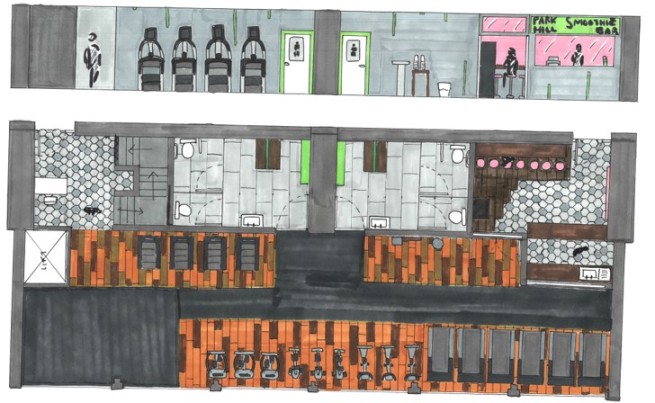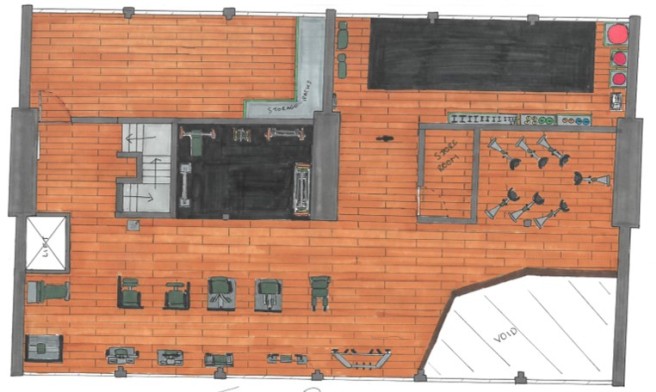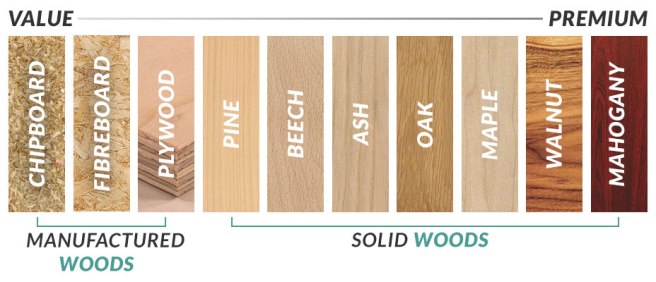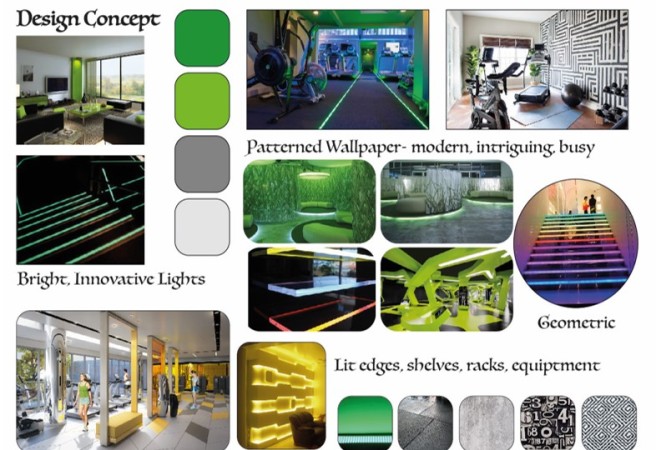These are my final outcome perspective drawings that I edited in photoshop. They show the smoothie bar, seating area, changing room, reception, weights area, balcony and spin area.

These are my final outcome perspective drawings that I edited in photoshop. They show the smoothie bar, seating area, changing room, reception, weights area, balcony and spin area.

These are my Floor Plan and Section drawings for my gym and smoothie. I made these using fine liners and coloured marker pens to suggest colours and textures within the space.




Properties of different types of wallpaper:
The wallpaper needs to be easily removable and abrasion free as to keep the concrete walls undamaged since they are listed.
Materials:
Solid Sheet Vinyl:
100% vinyl material, commonly embossed to give texture, quite durable and are usually scrubbable, making them easy to clean and maintain. They are also peelable which means the wallpaper will peel off the wall easily, leaving some of the backing on the wall, which can typically be removed with soap and water.
Non-Woven:
An advanced, technically improved wallpaper material made of a fibrous material. Easy to install and remove. They will dry-strip from the wall, usually leaving the wall smooth and abrasion free.
Easy-Walls:
Environmentally friendly, vinyl free, with no PVC or VOC and is printed with water based inks. It is easy to install and remove without harsh chemicals, and are also washable and breathable, inhibiting mold and mildew
Paper: Not as common but still present in the marketplace. They are environmentally friendly and showcase flat inks and designs very nicely, but due to the delicate nature of paper, these wallpapers have proven to tear easily during the removal process.
Acrylic Coated/Vinyl Coated Paper:
Printed on paper and treated with a coating for durability and washability/scrubbability. These wallpapers are easily maintained and are unaffected by long term exposure to humidity making them ideal for kitchens.
Expanded Vinyl:
Printed with a special ink that expands with heat giving them a raised surface effect known as “blown” creating a soft but textured wallpaper. It is a common printing technique used to create faux effects like bricks, woods and stones.
Heavy-Weight Vinyl:
Deeply embossed using a thick vinyl material. They offer a luxurious look and feel and are commonly used in Italian wallpaper manufacturing.
Fabric-Backed Vinyl:
Have a fabric backing which makes them highly durable. Because of their ability to be bumped and scratched without being damaged, these are most commonly used for commercial jobs where high levels of durability are needed.
Molded Linoleum:
Highly durable and dimensional wallcovering that replicates the feeling of custom molding or paneling which can be top-coated with any paint or stain for desired effects.
Match:
Straight Match:
Wallpapers with a straight match have a pattern that is continued across the width of the wallpaper. This means that the pattern continues across the seam and matched to the same point of the pattern on the next strip.
Drop Match:
Wallpaper patterns with a drop match do not repeat across the width from strip to strip. The next strip will need to be dropped either a quarter or half of the repeat on the next strip to match the pattern from strip to strip.
Random Match (Free Match):
Wallpaper with a random match has no design repeat, this means it does not matter where you match the next strip of wallpaper, it will always continue the design. Textures, grasscloths, and stripes are all examples of patterns with a random match.
Repeat:
The design repeat of a wallpaper tells you how many inches the pattern is vertically, until it repeats itself again. Patterns with no repeats (like textures) will have little waste, but larger designs may require more wallpaper.
Washability:
Scrubbable:
Scrubbable wallpapers can be scrubbed with a sponge and soap/ mild detergent, and has a higher level of durability than washable wallpapers.
Washable:
Washable wallpapers can be lightly cleaned with a sponge or a damp cloth. You should take care when cleaning washable wallpapers, but if you are gentle, they should clean easily.
Wipe with a damp cloth
These wallpapers should be washed gently with great care, they are more fragile than others and you should be careful cleaning.
Removability:
Strippable:
Strippable wallpapers can be dry stripped from the wall without leaving any backing behind. These are the most removable papers in the market and usually are printed on a Non-Woven substrate.
Peelable:
Peelable wallpapers will peel off the wall, leaving some of the backing behind. The backing can be often removed with soap and water.
https://www.brewsterwallcovering.com/wallpaper-properties.aspx
The different types of lights or lamps include the following
Incandescent lamps
Compact fluorescent lamps
Halogen lamps
Metal halide Lamps
Light Emitting Diode
Fluorescent tube
Neon lamps
High intensity discharge lamps
Low pressure sodium lamps
LEDs are the most commonly used. They are electronic components that emit visible light when electricity is passed through them. They are suited to both indoor and outdoor use and offer a number of benefits in comparison to incandescent lights.
These characteristics make LEDs more suitable for my lighting, since I want to use green tube lights to add colour and create a club like atmosphere in my gym, as well as using standard lighting in the ceiling and smoothie bar, which will have a more industrial feel.
http://www.ebay.co.uk/gds/What-are-the-Different-Types-of-LED-Lighting-/10000000178358071/g.html
Rubber flooring could be a suitable material for the gym as it provides a softer surface to exercise on. Rubber flooring is quite durable, is recyclable, renewable and eco-friendly. Types of rubber flooring include rolling sheets or tiles, which makes it easy to install by either clueing or interlocking tiles. This flooring type is mostly adapted in the areas like gyms, kitchens, outdoor patios, kids play rooms, basements, garages, laundry rooms, etc.
Pros of Rubber Flooring
– Easy to install and to handle.
– Excellent noise absorbents
– Highly durable material
– Tiles and sheets offer non-slippery surfaces, non-allergic properties, and anti-fatigue and foot friendly walk- helps to prevent injury
– Versatile, decorative, safe and easily available flooring material.
– Doesn’t require much upkeep and cleaning is easy. Generally resistant to stains damages and fading of colour.
– Moisture resistant, fire and burn resistant
– Excellent insulator that retains both cool and hot air accordingly.
Cons of Rubber Flooring
– Texture is important aspect before choosing. Smooth un-textured floors tend to become slippery in less time.
– Some cleaning agents, detergents, and grease might discolour the surface.
– When first installed it emits an unpleasant odor that diminishes with time.
– Rubber flooring for commercial application is quite expensive.
– Finishes are dull
Overall rubber flooring for weights areas and fitness areas would be important as it would provide a safer and more durable flooring for self-directed exercise. In terms of areas with large equipment, a harder, more solid floor is more suitable.
http://www.expressflooring.com/blog/rubber-flooring-properties-pros-and-cons/
Wood is a very common material to use in interiors, whether as flooring, countertops or within objects/furniture. There are many types of wood and each have different characteristics.
Hardwoods and Softwoods
Hardwoods come from broad-leaved trees that drop their leaves every year and produce seeds. They are slow growing trees so the wood is more dense and are usually much darker in colour. Items made from hardwoods are more likely to withstand years of wear and tear. However not all hardwoods are always hard, poplar and basswood are examples of these. Hardwood is commonly more expensive than softwood, however both are extremely popular within the furniture industry.
Hardwoods- Mahogany, Walnut, Oak, Ash, Birch, Maple, Cherry
Softwoods come from conifer trees that have needles and do not produce seeds. They are faster growing trees so wood is less dense and are usually lighter in colour. Softwoods are also cheaper than hardwoods.
Softwoods- Pine, Spruce, Cedar, Fir, Larch

Beech
Beech is hard, strong and heavy with a fine, tight grain and even texture. It is very light in colour and has a high shock resistance- popular for furniture.
Ash
Ash is a tough hardwood, known for its bending abilities. It is primarily used for bent pieces of furniture such as chairs with curved backrests. Ash is light brown in colour with a straight grain.
Oak
Oak is very popular, as it is hard wearing, heavy and has open wood grain markings. Oak can be purchased in two shades; white oak, which is grey/brown in colour or red oak which has a reddish tint.
Mahogany
Mahogany is an expensive hardwood and varies in colour from a medium brown to a deep red brown, depending on its age. It is a traditional, versatile and popular type of wood, especially for use on veneers.
Maple
Maple wood is more durable and heavier. Because it so strong and moisture resistant, it is ideal for withstanding years of wear and tear. Maple wood is pale in colour and has natural swirls and twists in the wood grain. It easily accepts any type of stain or paint.
Walnut
Walnut is a strong hardwood with straight grain and rich chocolate brown colour. Walnut can be a very versatile wood, offering a range of shades and grains.
Pine
Pine is affordable and lightweight with a pale finish which is great for staining. It is less durable but blends well with other woods.
Manufactured Wood Types
Fibreboard
Fibre board is an inexpensive manufactured wood made from the breaking down of hard or soft woods into fibres which are then bonded together with wax, resin and heat to create a dense piece of wood.
MDF (Medium Density Fibreboard)
MDF is very strong and popular. With its strong/dense structure, it is more durable, but is still inexpensive. In the majority of cases, furniture built with MDF will have a wooden veneer bonded to it to give it an expensive looking finishing touch.
Particle Board (Chipboard)
Chipboard is a manufactured wood, made from wood chips and shavings that are bonded together with resin. It is popular when making furniture as it has a dense structure and is commonly used with a veneered surface which is used for flat-packed furniture and work surfaces.
Plywood
Plywood is a very strong manufactured wood as it is build-up of layers of wood veneers which are bonded together to create a flat smooth sheet of wood. It is popular for furniture and flooring due to its strength and resistance to warping due to the bonded cross-ply construction.
Veneer
A veneer refers to a thin layer of wood which is cut from the circumference of a tree. It is then bonded onto a dense piece of wood, typically MDF, chipboard or plywood. Veneers are available in many sizes, ranging from 3 to 6mm thick. They quite often are used in high end furniture pieces so can be more costly than solid wood. As a veneer is real wood, it will accept stains and finishes much like solid wood.
https://furniture123.co.uk/content/wood-types
Concrete is made up of three components: water, aggregate (rock, sand, or gravel) and cement. Cement, usually in powder form, is a binding agent when mixed with water and aggregates.
Properties
Concrete has relatively high compressive strength, but low tensile strength, meaning it needs to be reinforced with materials that are stronger like steel. It has constant elasticity at low stress levels but decreases at higher levels. Low thermal expansion means as it matures, concrete shrinks, leading to cracking due to shrinkage and tension. The density of concrete varies, but is around 2,400 kilograms per cubic metre.
Reinforced concrete is the most common form. The reinforcement is often steel, rebar (mesh, spiral, bars), or structural fibres of various materials. Concrete can also be prestressed using internal steel cables, reducing tensile stress.
Desired qualities of the hardened concrete include resistance to freezing and thawing and de-icing chemicals, water tightness (low permeability) , wear resistance, and strength.
Concrete Admixtures: Admixtures are additions to the mix used to achieve certain goals.
Accelerating admixture-accelerators are added to concrete to reduce setting time of the concrete and to accelerate early strength. The amount of reduction in setting time varies depending on the amount of accelerator. Calcium chloride is a low cost accelerator, but nonchloride accelerator prevent corrosion of reinforcing steel.
Retarding admixtures-Are often used in hot weather conditions to delay setting time. They are also used to delay set of more difficult jobs or for special finishing operations like exposing aggregate. Many retarders also act as a water reducer.
Fly Ash– Is a by product of coal burning plants. Fly ash can replace 15%-30% of the cement in the mix. Cement and fly ash together in the same mix make up the total cementious material. Fly ash improves workability, is easier to finish, reduces the heat generated by the concrete, and costs to the amount of the cement it replaces
Air Entraining Admixtures– must be used whenever concrete is exposed to freezing and thawing, and to de-icing salts. Air entraining agents entrains microscopic air bubbles in the concrete: when the hardened concrete freezes, the frozen water inside the concrete expands into these air bubbles instead of damaging the concrete. Air entrainment improves concrete workability, durability, and produces a more workable mix.
Water reducing admixtures-reduces the amount of water needed in the concrete mix. The water cement ratio will be lower and the strength will be greater. Most low range water reducers reduce the water needed in the mix by 5%-10%. High range water reducers reduce the mix water needed by 12% to 30% but are very expensive and rarely used in residential work
My design had two separate areas, the gym and the smoothie bar, and will have slightly different atmospheres whilst still being connected. Balancing exercise and diet is important as doing just one will make little impact to your health.
My design within the gym will use neon lights to create a club like atmosphere so that it will feel accessible to use at any hour, whether day or night. I also want to preserve the history of Park Hill, following its Brutalist style and expose the concrete rather than hide it.

My brief for this module is to explore the idea of creating healthy spaces within two 2 storey units in Park Hill, responding to the existing building, site and restrictions. Creating a research portfolio, design portfolio and sketchbook, as well as using the blog to upload information about different materials.
Using my research to create a design scheme, I then will developed a proposal for a space in Park Hill that encourages good healthy and wellbeing, addressing issues such as:
My Proposal
Park Hill needs a space that can help to promote good health and wellbeing, addressing problems with low physical activity and unhealthy eating. My proposal is a combination of ideas:
A gym with workout equipment and weights area
Fitness Suite with scheduled classes such as yoga, HIIT, spin, etc
Smoothie bar/ café to help promote healthy eating after exercising
This is aimed for residents of all ages so that it can address issues with obesity, low activity and unhealthy eating, which affects all age groups.
It can also help towards problems with mental health, stress and anxiety as exercise and healthy eating is proven to help release chemicals that help fight depression. It can also help prevent social isolation as fitness classes can provide opportunities for new friends and conversations, whilst working out together.
Park Hill is a council housing estate, originally designed by two architects, Jack Lynn and Ivor Smith. It was important for meeting the demands for housing after the war, overall creating homes for over 3000 people. The scarcity of bricks at the time meant that concrete was used, leading to a rise in Brutalism, a style that preferred to expose the structure of the building rather than to conceal them.
Park Hill was officially opened in 1961, being an alternative to back to back slum housing. When first opened, this estate was extremely popular, with residents of all ages and backgrounds. As well as providing around 1000 new homes to Sheffield, the inclusion of shops, bars, schools, and even a keep fit place provided residents with essentials and improved health and wellbeing.
By the 80s, Park Hill declined in popularity, becoming more prone to crime, drugs, and violence. For Park Hill to survive, it needed high maintenance, which was costly, leading it to become unpleasant, dull and, according to residents, prison-like.
In 1998, Park Hill became a Grade II* listed building, despite its state of disrepair. This brought on outrage by many, including the Liberal Democrats who campaigned to have it demolished. In 2005, it was taken on by Urban Splash who aim to restore Park Hill to a thriving residential area, more suited to contemporary styles and needs.
Park Hill was known as the ‘Streets in the Sky’, the concept being that it brought the streets skyward, creating quieter streets within the city and allowed residents to walk the streets under cover from rain, as well as providing enough room for a milk float to travel through.
This estate has potential to become key to Sheffield. The return of shops, bars, and other facilities that were once a huge part of the estate, could make Park Hill a model of good health and wellbeing, as well as providing affordable housing for the increasing demand.
Location
Park Hill is located 5 minutes from Sheffield City Centre and 2 minutes away from the train station, making it an ideal location for new potential homeowners. It is situated on one of the 7 hills of Sheffield to the east of the city centre within a park, providing a more calming environment, despite its city location.
In terms of shops and facilities, it takes around 15 minutes to walk to the nearest shop, 5 minutes to the nearest bus station, 5-10 minutes to the nearest church and 15 minutes to the nearest gym.